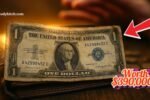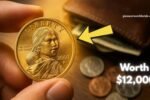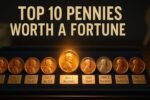1935 $1 Silver Certificate : Sometimes the most valuable treasures hide in the most ordinary places. That’s exactly what happened when a 1935 $1 silver certificate was found tucked among regular pocket change. What appeared to be just another outdated dollar bill turned out to be worth a staggering $390,000. This discovery serves as a powerful reminder that rare historical artifacts can still turn up where we least expect them—even in the change we carry around daily.
What Is a 1935 $1 Silver Certificate?
The 1935 $1 silver certificate is a piece of U.S. paper currency issued during a time when paper money was backed by actual silver held in the U.S. Treasury. These notes were once redeemable for silver coins or bullion, giving them real monetary weight. Though millions were printed, only a small number carry rare features—like printing errors, unique serial numbers, or special design elements—that make them extremely valuable today.
Why This Particular Bill Is Worth $390,000
While most 1935 silver certificates are worth only a few dollars today, this specific note stood out due to its extraordinary rarity and condition. It’s likely that the bill possessed a rare printing error or a unique serial pattern, and was preserved well enough to remain in near-pristine shape. These qualities combined to dramatically raise its value, making it one of the most remarkable paper currency finds in recent memory.
A Valuable Find Hidden in Plain Sight
What makes the story even more remarkable is where the note was found—casually sitting among everyday change. This wasn’t a bill kept locked away by a collector; it was something anyone could have overlooked. The fact that a nearly $400,000 item could pass unnoticed for decades only adds to the mystique, and shows how easy it is to miss incredible finds hiding in plain view.
A New Wave of Interest in Paper Currency
After news of the discovery spread, interest in collecting old paper money surged. People began digging through boxes, drawers, and even family heirlooms to see if they might own something similar. For both novice collectors and seasoned hobbyists, this story reignited a passion for currency history and encouraged others to pay closer attention to the bills that pass through their hands.
A Lesson in the Hidden Value of the Past
Beyond its monetary value, the 1935 silver certificate tells a deeper story about history, awareness, and the possibility of everyday magic. What may seem like a common or forgotten object can sometimes carry enormous worth—both financially and historically. This discovery reminds us that sometimes, the past isn’t locked away in museums or archives; it’s quietly waiting in our pockets to be noticed and appreciated.
Frequently Asked Questions (FAQs..)
Q1: What is a silver certificate?
A: A silver certificate is a type of paper currency that was once issued by the U.S. government. It was redeemable for an equivalent amount of silver from the Treasury. While they are no longer exchangeable for silver, they are still legal tender and are popular among collectors for their historical value.
Q2: Why is the 1935 $1 silver certificate significant?
A: The 1935 series was widely printed, but some rare variations—such as printing errors, unusual serial numbers, or special markings—make certain bills from this series highly collectible and extremely valuable.
Q3: How did a $1 bill end up being worth $390,000?
A: The $390,000 valuation likely came from a rare version of the 1935 silver certificate that had unique traits, such as an error print, rare serial number, or being in pristine condition. These factors dramatically increase a note’s collectible value.
Q4: What kind of errors make these bills valuable?
A: Common valuable errors include misprints, ink smears, off-center printing, double serial numbers, and inverted seals. These mistakes occurred during production and are very rare, making them highly sought after.



